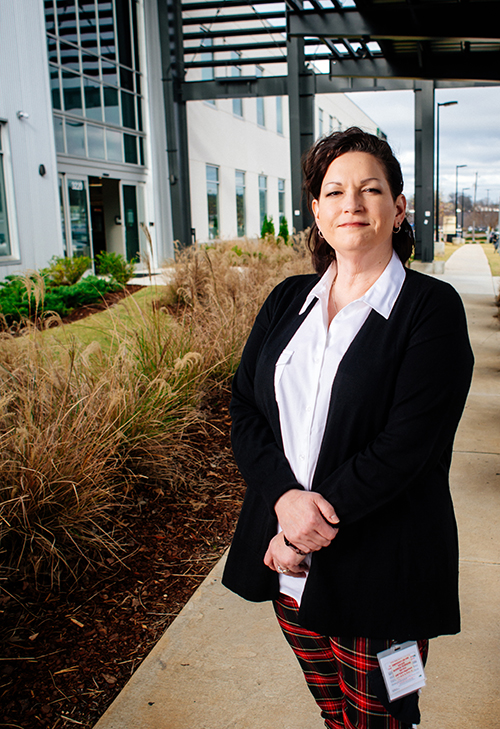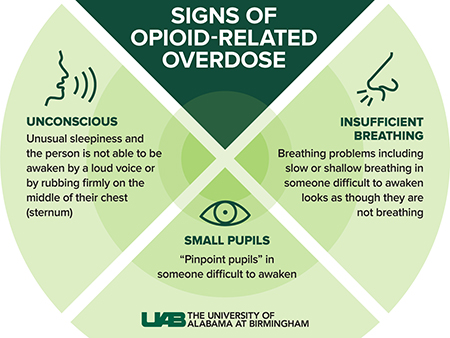 Marsha Hawkins never thought she would become so passionate about helping her patients and potentially others who might have exposure to prescription or illicit drugs. (Photography by Steve Wood)During the COVID-19 pandemic, deaths related to overdose of prescription and illicit drugs have increased by nearly 25 percent in Alabama. One nurse at the University of Alabama at Birmingham’s 1917 Clinic is making it her mission to help prevent overdose deaths by leading a Naloxone-prescribing initiative to her patients.
Marsha Hawkins never thought she would become so passionate about helping her patients and potentially others who might have exposure to prescription or illicit drugs. (Photography by Steve Wood)During the COVID-19 pandemic, deaths related to overdose of prescription and illicit drugs have increased by nearly 25 percent in Alabama. One nurse at the University of Alabama at Birmingham’s 1917 Clinic is making it her mission to help prevent overdose deaths by leading a Naloxone-prescribing initiative to her patients.
In 2020, Marsha Hawkins, a nurse with UAB’s 1917 Clinic, began working on a quality control program — making sure patients were compliant with their medicines and drug refills. One year later, Hawkins never thought she would become so passionate about helping her patients and potentially others who might have exposure to prescription or illicit drugs.
In Jefferson County, there were more than 300 reported opioid- or fentanyl-related overdose deaths in 2020 — the highest ever.
“Because we have a large clinic with many aging patients, many are prescribed opioids from other physicians for things like post-surgical pain and cancer, and I noticed some patients may not have taken it as it was prescribed,” Hawkins said.
Because Alabama has seen increasing overdose deaths since the COVID-19 pandemic began, Hawkins and other nursing staff at the 1917 Clinic developed the 1917 Know Overdose Initiative. The initiative, which is primarily nurse-driven, educates, identifies and prescribes Naloxone for individuals who have been identified as at high risk for overdose.
Hawkins says she provides Naloxone prescriptions for patients who have small children in the home, but receive opioids through UAB’s Chronic Pain/Controlled Substance Program.
How Naloxone works
Naloxone is an easy-to-use medication, available in nasal spray and injectable form, for the temporarily reversal of the effects of opioid medicines. It acts as a blockade between the opioid drug and the receptors in the brain. Naloxone has no effect in people who have not taken opioids, so if the person has overdosed on another substance, it will not help but also will not hurt.
“Ideally, I try to educate a family member/caregivers/partner along with the patient in the use of Naloxone, since it would be highly unlikely that the patient would be able to use the Naloxone themselves in the event of overdose,” Hawkins said.
Hawkins says other non-opioid street drugs have been laced with illegally made fentanyl that can result in overdose even in the smallest of amounts. This has resulted in opioid overdose deaths in people who were not even aware that the opioid drug was being ingested.
“Due to this, the providers here at 1917 Clinic will contact me to meet with their patients who are using any street drug, even marijuana, due to high rates of drug contamination with fentanyl,” she said.
UAB Marnix E. Heersink School of Medicine associate professor Ellen Eaton, M.D., says many providers still do not understand the use of Naloxone.
“We started pushing Naloxone before the pandemic, with the use increasing in the last five years; but during the pandemic, we have accelerated its use and awareness of how it can help,” Eaton said. “Through this initiative at 1917, we are starting with education and awareness, because a lot of providers still don’t understand the use of Naloxone. Some providers may feel it can be misused or cause harm. But, this is a medication that has no abuse potential. It is not a narcotic or an opioid. It saves lives.”
 Hawkins and Eaton suggest family members of those who use opioids should be aware of the signs of overdose, which include:
Hawkins and Eaton suggest family members of those who use opioids should be aware of the signs of overdose, which include:
- Unusual sleepiness and the person is not able to be awaken by a loud voice or by rubbing firmly on the middle of their chest (sternum)
- Breathing problems including slow or shallow breathing in someone difficult to awaken or who looks as though they are not breathing
- “Pinpoint pupils” in someone difficult to awaken
Eaton says Hawkins has been instrumental in providing education and assistance to so many who need it.
“Marsha has been a champion for this cause,” Eaton said. “I think she saw the need and that there was no system or process to get Naloxone to these patient populations, so she just developed her own protocol based on the evidence that was in front of her. She has gone above and beyond.”
Any resident of Alabama has access to a free Naloxone kit without a prescription. To learn how you can receive yours, click here.
